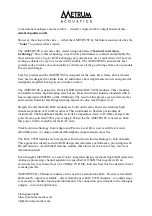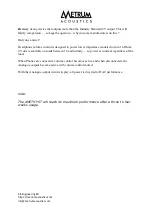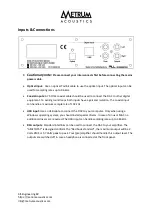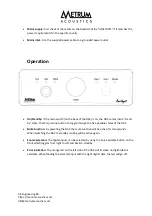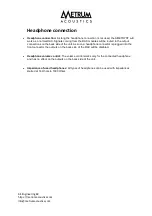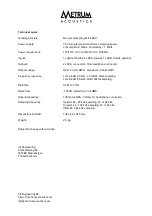
All-Engineering BV
https://metrumacoustics.com
info@metrumacoustics.com
Conventional analogue volume control … directly coupled to D/A output board ensures –
detailed quality sound
.
However, the icing on the cake … is that the AMETHYST by Metrum Acoustics also has the
” looks “
to partner what’s inside.
The AMETHYST is our new entry model using our praised “
forward correction
technology
“. Due to this technology a real 24 bits performance is realized and probably the
most advanced way to give R2R technology new dimensions. As a result music will be more
exiting as details on very low levels will be audible. The AMETHYST can meet the best
systems today in terms of sound quality as it borrows all the good things from our top models
Pavane and Adagio.
Like her predecessor the AMETHYST is designed for the same basic frame but electronics
have been redesigned for future tasks. In addition we have implemented a new and powerful
headphone amplifier having its own volume control.
The AMETHYST is using two Transient R2R ladder DAC TWO modules. These modules
can handle extreme high sampling rates but are limited to current industry standards which
has its maximum (384kHz) on the USB input. The result of this process is an extremely fast
and accurate behavior and brings listening experience on a much higher level.
Despite the fact that both DAC modules are build on the same board an extremely high
channel separation of 110 dB is realized. This contributes to flawless positioning of
instruments. The headphone amplifier will drive impedance down to 16 Ohms and gets his
power from a powerful 30VA power supply. When the the AMETHYST is used as a DAC
this power will be available for the DAC only.
Trickle down technology from Adagio and Pavane Level III, is now available at a most
affordable price. A volume controlled Headphone output almost comes free.
The DAC TWO modules each incorporate Forward correction technology to both channels.
This approach is ideally suited to R2R design and maximizes performance, providing true 24
Bit performance. As with the Reference models, this allows for retrieval of very low level
information/detail.
Even though AMETHYST is a small ‘mini’ integrated design, incorporating both Digital and
Analogue processing, channel separation is specified at 110dB. This together with an
extremely low level noise floor of -145dB @ 2V RMS, indicates how this fine detail retrieval
is made possible.
AMETHYST By Metrum Acoustics can be used as a stand-alone DAC. Fixed level standard
Redbook 2V output is available – direct from the new DAC TWO modules – no output stage
is necessary to hinder/cloud signal information. The connection goes straight to the Analogue
outputs – to feed Amplification.


